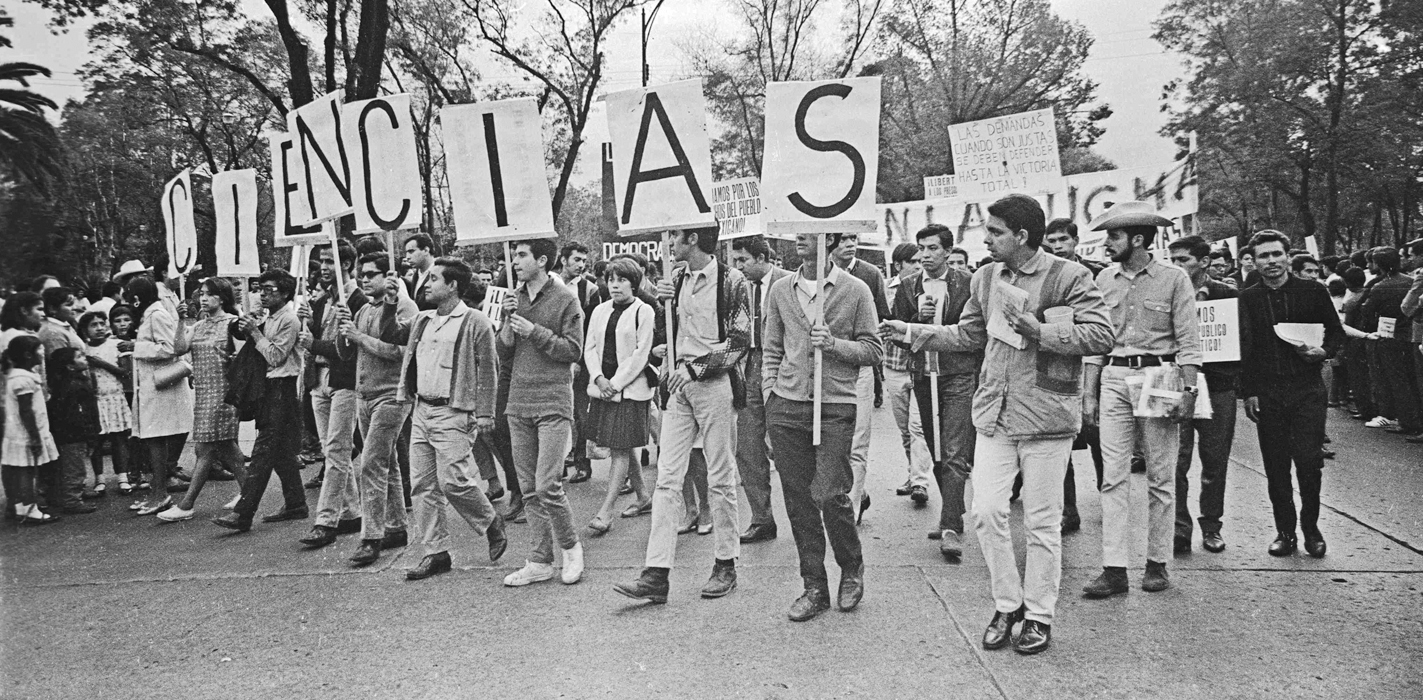Beyond America’s Borders: 1968: A Year of Protest
Printed Page 808 Chapter Chronology
Beyond America’s Borders: 1968: A Year of Protest
1968: A Year of Protest
To many people living through it, 1968 looked like the start of a worldwide political revolution. A surge of protests against the U.S. war in Vietnam and demands for greater democracy and economic justice jumped over borders and challenged authorities in many countries around the world. Although local grievances ignited many of the protests in 1968, a common feature of them all was the central role played by university students. The protests of 1968 unfolded rapidly, giving rise to excitement and apprehension. From February to December, demonstrations erupted in North and South America, Europe, and Asia. Many demonstrators expressed transnational solidarity by carrying the flag of Vietnam's National Liberation Front or placards bearing the image of Ernesto "Che" Guevara, a Latin American radical killed by the Bolivian military in 1967. And yet there was in fact little international coordination of events or any shared plan for remaking the world.

One of the first large-scale protests occurred in February at West Berlin's Free University, where some 10,000 participants from ten countries at the "Vietnam Congress" called for "an international manifestation of solidarity" with the people of Vietnam. Protests continued throughout the spring, prompting the West German government to pass emergency laws to stifle disorder. In February and March, demonstrations flared up in Madrid, Warsaw, Rome, São Paulo, and London, met by police with clubs. As with the protesters, police also took their cues from worldwide events, reacting more forcefully to demonstrations in light of commotions in other countries. Charges of police brutality, disseminated in television and newspaper reports, fed the cycle of protest further.
In April and May, violence erupted in the United States. Martin Luther King Jr.'s assassination on April 4 ignited riots in many U.S. cities. Less than a month later, students at Columbia University in New York City seized buildings and shut down the campus, leading to a bloody showdown between police and protesters.
In May, rebellion paralyzed France. It began with students' complaints about services at a university north of Paris and spread to the Sorbonne in the capital city. Police teargassed a small rally, only to face tens of thousands of students streaming into Paris over the next few days. Violence escalated as protesters barricaded streets. Independent radio stations broadcast live interviews with demonstrators, and soon a million people were in the streets. Workers joined the rebellion, shutting down factories across France. Students proclaimed that "exceptional domestic and international conditions" had brought powerless students and workers together around the world. By late May, France was in deep crisis.
Prague, the capital of Communist Czechoslovakia, also stirred in May. A liberal president, Alexander Dubček, pushed for reforms against heavy-handed Soviet control, giving rise to hopes for greater freedom. Students demonstrated, and thousands signed manifestos. But this "Prague Spring" was cut short in August when Soviet tanks rumbled into the country and Dubček was arrested. Throughout Europe, students marched on Soviet embassies to protest the crackdown. At the same moment in the United States, Chicago police battled young protesters near the Democratic National Convention.
In July, Mexican police attacked marchers carrying posters of Fidel Castro and Che Guevara. When thousands rallied against the violence, police fired into the crowd, killing several students. Violent clashes continued into August and September, as activists protested the Olympic Games, scheduled to open in Mexico City in October. Insisting that the money spent on the Olympics should have been used to alleviate the country's widespread poverty, protesters chanted, "We don't want Olympic Games; we want revolution." The upcoming Olympics created pressure for the authorities to clear the city of dissidents. When some 10,000 students assembled for a rally on October 2, jeeps with machine guns arrived. At least 100 to 200 protesters were killed, and another several hundred were wounded. The Olympic Games went on as scheduled ten days later.
In the wake of the massacre, protesters staged demonstrations and attacks on Mexican embassies in Latin America and Europe. By December, more episodes of violence against protesters occurred in Spain, Pakistan, and Northern Ireland. In the United States, violence diminished generally, but not in urban ghettos.
By year's end, a kind of stunned exhaustion set in. The Soviets had shut down the Prague Spring, the student-led protests in France and Germany had reached a stalemate, and Republican Richard Nixon had won the U.S. presidential election with promises to maintain law and order at home and to end the war in Vietnam. The year of global protest ended with despair and fear on all sides. Student protest did not disappear, but the excitement of worldwide revolutionary solidarity was blunted by the very real threat of fatal consequences faced by protesters.
America in a Global Context

Question
zgIup1mPdXHA7bFqcIL8fUlRjQ6I4SsvRqC17kXyGZxwzL+CV/SfwzJuOHNR+cBH2rludddQa5h3L77T98QOFvHglOsDfgejR3QxgZwQ/7gA/grrfMWb87JLdy0pytrR
Question
ofqzDksUFrsT7gXRg1ewU9GKMwY4sCR3IPah5cnlZ8Z3xkzLrnCEZRYl3A3RoisN3MoQOXKMt+Z1z/jmNVEbeWwE0vRR6ngsqCnQDTWKA2xb4UXnZAYdRleyCSded/Bq4Yklh6GaWlx6k56mZA2UE3MB5Ltj0qTd74VEKHZ9z+2xYZhGWzKdX5Dy8kvW7o2tg90YkSYUT+KDGvoMHoC5Mg==CONNECT TO THE BIG IDEA
